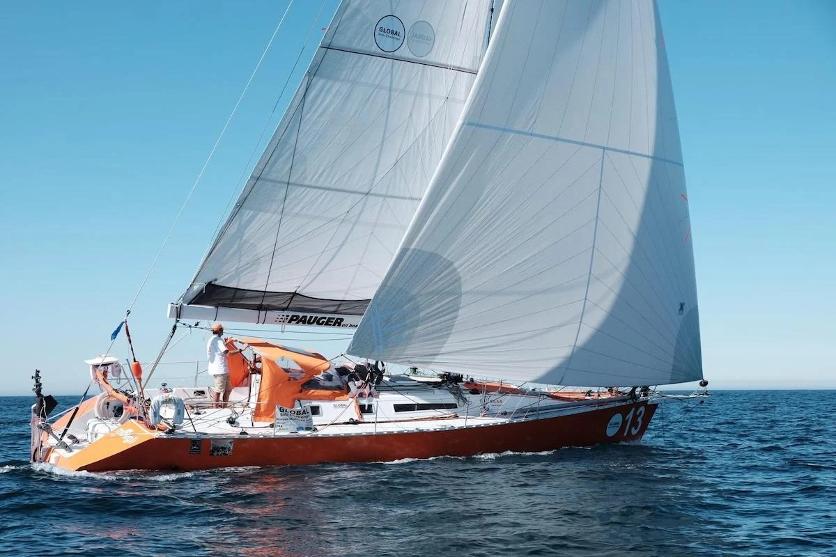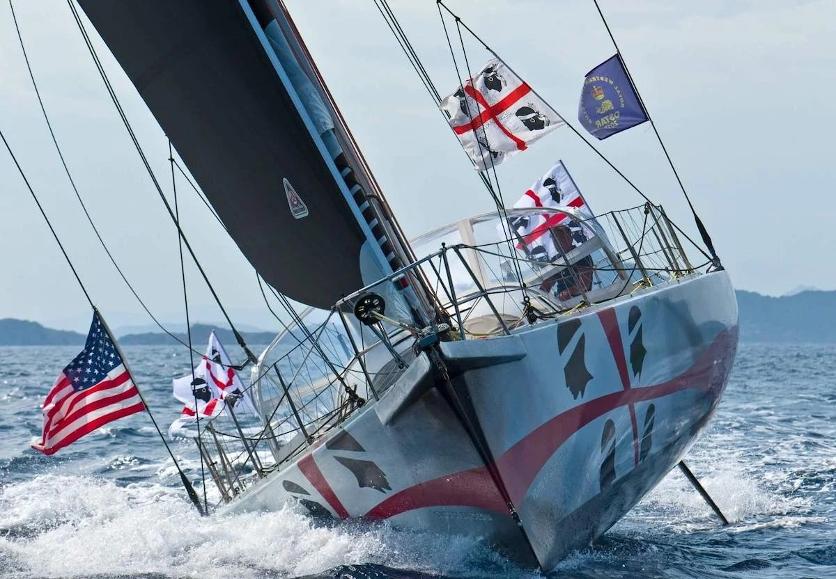Why will your standing rigging benefit greatly from replacing the steel wire with composite fibre stays? I have been thinking of the advantages of composite rigging while following the different races and yachts challenges circumnavigating the world. With so many people chasing the dream of crossing oceans and sailing around the world, the importance of fitting your boat with the right material is paramount.
Standing rigging on ocean racing yachts
The Golden Globe Race (GGR) and the Oceans Race finished earlier this year. The Clipper Round the World Race is underway and the staggered start for the Global Solo Challenge (GSC) is now completed and the challenge is underway.
One aspect that fascinates me is the punishment these yachts, their rigs and the sailors endure, particularly in the Southern Ocean. The drop-out rates are high, with many retirees being forced out of their respective races by catastrophic breakages of their rigging and consequent dismasting and other failures. A great example of this was in the GGR - only three boats crossed the line to complete the course (without stopping for repairs) out of sixteen starters!

Image Credit - Global Solo Challenge
I have also followed the incredible amount of work that has been undertaken by the entrants to the GSC as they prepare their second-hand yachts for the challenge. By studying these races, the work in preparation for these events and understanding the failures and successes, I believe we can start to understand the stresses the yachts undergo and how to improve the performance of all our sailing hardware, including the navigation equipment, sails, running and standing rigging.
And whilst I am not going anywhere near the Southern Ocean anytime soon, I am looking at the developments in standing rigging, particularly as to the safety aspect as well as the advantages. The costs and the ease of rigging that could be achieved by changing over from steel wire stays, in particular, the backstay, to composite materials are quite impressive.
Is composite rigging lighter?
Standing rigging takes a lot of a boat’s weight, so the most obvious advantage in changing to composite material is weight. Not so much a finesse to make you go faster (though it helps), but it is predominantly a matter of stability.
Though there are many factors to be considered, Naval Architects commonly say that for every extra kilo of weight at the masthead, you need to counter this with between 7 and 10 kilos in ballast to achieve the same stability. So, reducing weight in your standing rigging will lower your boat’s centre of gravity, which will increase your boat’s stability, as well as its overall handling. It will improve your yacht’s ability to right itself and will even reduce your yacht’s roll when you are safely at anchor (I am sure that after a restful night’s sleep without your boat rolling around, you will thank me for this advice!).
Rigging professionals report that changing over to composite rigging could reduce the weight of the rigging by up to 75%. To show how dramatic effect this changeover can have on the weight on an 80-foot yacht, the weight of the traditional standing rigging readily reaches over 300 kg, compared to 80 kg if you were to use composite stays made of the material PBO or carbon. This means that to retain the same stability you could, in theory, reduce the amount of ballast by about 1,000 kg.
Doesn’t composite rigging stretch?
Those salty seadogs, who seem to think they know everything about boats, will claim that composite rigging stretches. This maybe a valid conversation when talking about lower-tech Dyneema® standing rigging but is not an issue with normal standing rigging materials such as Carbon, PBO and Kevlar.
When changing over to new composite standing rigging, it will be specified on a stretch equivalence basis and will therefore be the same stiffness with similar stretch characteristics as the old wire/rod rigging. This means that the mast will be properly supported and perform as it was designed, but with the major advantage of 75% less weight.
However, stretch is an important consideration when looking at using Dyneema® for lateral rigging. This is a relatively cost-effective solution for offshore cruising boats from 30-50ft, but it requires a completely different philosophy to rig management. You cannot simply set up the rig and leave it. You have to be constantly adjusting and tightening the rig – it takes a lot more “active management”.
The reason is that Dyneema® suffers from Creep which is physical elongation under constant load. Most yacht turnbuckles only have 75-150mm of adjustment but with Dyneema® rigging you need to be able to deal with +300-500mm of creep, depending on the cable length and diameter. The only current method of managing this amount of length change is to use lashings at the bottom of the stays. Over time, the rig tension will become slack and the lashings will need to be tightened. It is for this reason that Dyneema® standing rigging is only suitable for a certain style of sailing where repeatable rig tune settings are not critical.
N.B. PBO, Carbon and Kevlar do not suffer from creep and utilise standard turnbuckles to manage rig tension.
Is composite rigging strong enough?

Image credit - Vento Di Sardegna/Global Solo Challenge
Composite rigging is significantly stronger than wire, for a given stretch. A composite rigging manufacturer will make new composite stays to be exactly the same stiffness as the original wires that they are replacing. However, due to the composite material properties, the finished cables will be between 4 to 6 times stronger than the original wire stays.
With Dyneema® rigging one method of limiting creep is to increase cable strength relative to working load. A Dyneema® stay working at 50% of its break load will creep very quickly. However, if a stay is specified to be working at or below 20% of its break load then the rate of creep will be dramatically reduced.
A rule of thumb in the industry for wire and rod is to have a Factor of Safety (FOS) of 2-2.5x. This means for a cable working load of 1000kg the break load should be 2000-2500kg (N.B. this also applied to metal fittings – shackles and toggles etc). However, based on their material properties, for the same stretch equivalent cable, PBO/Carbon and Kevlar will have a minimum Factor of Safety of 4-5x and with Dyneema® it often raises to 5-6x, to reduce creep.
Therefore, composite rigging is inherently stronger than metallic rigging.
Are composite stays more fragile? What about the risk of damage?
Abrasion is probably the number one risk with composite rigging, relative to wire and rod. However, this is a manageable risk compared to some of the other hidden risks with wire/rod.
Composite stays will generally have multiple layers of sacrificial braid to protect the core, load-carrying fibre, from UV and abrasion damage. Fluffing of the outer braided cover is an obvious sign that abrasion is occurring, and remedial action can be taken, quite easily by applying local protection to the surface of the cable. Some superyachts and race boats use a light-coloured braided layer, under the main dark-coloured cover, to ensure that penetration of the first cover is highly visible and early action taken, to prevent any damage to the core.
With wire/rod cables and metal fittings in general – damage can often develop, hidden away inside wire and interface fittings. This is particularly relevant at the bottom of the stays, at the junction with a swage terminations, where water (and salt) can sit within 1x19 wire, causing internal corrosion, which cannot be fully appreciated simply by an external inspection.
So, yes, composite stays require vigilance against abrasion, but the risks are potentially easier to manage than with the hidden problems that can develop with wire/rod.
OK – I am convinced. How do I make a start?
Complete retrofits from wire/rod to composite standing rigging can be quite challenging and complicated. The switch also takes a mindset change, which is why Upffront believes it is best to “dip your toe in the composite water”. The easiest way to get started is to change your wire/rod backstay to composite. For 20-45ft boats this can be done relatively simply and cheaply.
Most cruising boats will have a single backstay, pinned in the mast crane at the top, with some sort of length adjustment at the bottom end. Generally, Upffront will specify Gottifredi Maffioli Ultrawire SK99 in this application and the new composite cable can be slotted into the pin in the mast cane with a thimble at the lower end which allows lashing attachment to virtually any purchase / adjuster system at the bottom end.
My own inclination is that once a sailor tries a composite backstay, they will readily appreciate the many advantages and will soon look to make the transition to full composite rigging.
A switch out to a composite backstay can take less than 30 minutes before the rig goes in the boat next season. This is also one of the final benefits of composite rigging - the ease of rigging and handling. Composite cables are lighter, cleaner, more readily transportable, can be coiled and due to their light weight – it is far more viable to keep spares onboard.
Do not delay - see Upffront’s range of solutions for composite backstays at:
If you have any questions about standing rigging systems or need help choosing one of the products on our website, please feel free to email us at [email protected] to talk to one of our experts...


Standing Rigging: Why you should change to composite rigging